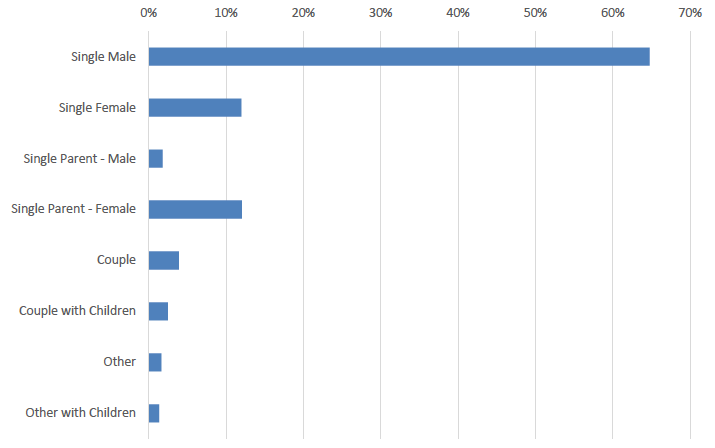Homelessness in Scotland: 2018 to 2019 – equalities breakdown
This bulletin provides information about homelessness in Scotland, with a focus on the equalities characteristics of homeless applicants.
Temporary Accommodation
(Tables 11 to 17)
Homeless applicants may be placed in temporary accommodation while the Local Authority assesses their application or while awaiting the offer of a permanent let.
The characterstics used in this section are taken from the homelessness application (the HL1 data collection), however in some cases this may not accurately reflect who is present in a temporary accommodation placement. This is because there are cases where for example a household with children will make a homelessness application but make alternative temporary accommodation arrangements for the children (e.g. living with relatives).
Numbers of households
Between 1st April 2018 and 31st March 2019, a total of 21,095 unique households entered temporary accommodation. Around 63% of these were aged between 18 and 49. 50% of those entering temporary accommodation were single male households, while 19% were single females. 76% were of White Scottish ethnicity. These percentages closely match those for homelessness applications as discussed above.
Duration in temporary accommodation
The average length of time spent in temporary accommodation across all households was 180 days (approximately 6 months). Households where the main applicant was aged between 35 and 49 were in temporary accommodation for 196 days on average, while the figure was 150 days for households aged 65 or over.
Single male households spend more time in temporary accommodation on average than female households (167 days compared to 162 days), although female single parent households spend more time than male single parents (208 days compared to 192 days).
Households of African ethnicity on average spend longest in temporary accommodation on average (247 days), followed by Caribbean or Black households (226 days). In particular Caribbean or Black households of ‘Other’ household type (households with 3 or more adults) on average spent 629 days in temporary accommodation, and African households of type ‘Other with children’ on average spent 560 days in temporary accommodation on average.
Number of placements
The majority (59%) of households that exited temporary accommodation during 2018/19 had one placement in temporary accommodation. Almost a quarter (24%) of households had two placements in temporary accommodation and 18% had three or more placements. This reflects that most households using temporary accommodation are placed once, but that there are some who move through multiple temporary accommodation placements.
Older applicants are less likely to have multiple placements, with 70% of main applicants aged 65 and over having just one placement in temporary accommodation.
Single males and couples are most likely to have more than one placement in temporary accommodation, with 45% of single males and 46% of couples having more than one placement. 42% of single female households had more than one placement, while just 34% of households containing children[11] have more than one placement in temporary accommodation.
Households where the main applicant is of African, Caribbean or Black, Mixed or multiple ethnic groups are more likely to have more than one placement in temporary accommodation (65%, 65% and 64% respectively) compared to 41% of all households that exited temporary accommodation, although these households account for only a small proportion of temporary accommodation placements.
Applications in which temporary accommodation was not offered
An HL3 return is completed when a local authority has a statutory duty to provide temporary accommodation under the homeless person’s legislation, however, a local authority is also required to indicate when they do not offer any temporary accommodation to a household and thus, are acting unlawfully.
During 2018/19, 3,540 HL3 applications were ‘not offered’ temporary accommodation. The majority of these cases (65%) were single male applicants, with a further 12% being single female applicants. 18% of those ‘not offered’ temporary accommodation were households including children, however as noted at the start of this section, the children recorded as in these households may not actually require temporary accommodation as their parents/guardians may have made alternative arrangements for them.
65% of cases were temporary accommodation was not offered were single male households

In addition, 69% of those not offered temporary accommodation were of White Scottish ethnicity. Applicants in the age groups 25 to 34 and 35 to 49 together accounted for 74% of those applications not offered temporary accommodation.
Breaches of the Unsuitable Accommodation Order
The Homeless Persons (Unsuitable Accommodation) (Scotland) Amendment Order 2017, limits the number of days that local authorities can use unsuitable accommodation, such as bed and breakfasts, for families with children or pregnant women to 7 days, except in exceptional circumstances.
In total, there were 617 breaches of the Homeless Persons Unsuitable Accommodation Order during 2018/19, this accounts for about 2% of all temporary accommodation placement cases closed during this time period.
Three quarters of placements where a breach occurred had a female main applicant, with over half (56%) of all breaches in 2018/19 affecting female single parent households. This is partly due to the definition of a breach, which means households affected will always include a pregnant woman or contain at least one child.
Households including children are by definition, much more likely to be affected by a breach. 6% of closed temporary accommodation placements involving a household with children are affected by a breach, this compares to 2% of temporary accommodation placement cases closed during 2018/19.
Households where the main applicant is Caribbean or Black, White Polish or Asian, Asian Scottish or Asian British are also more likely to be affected by a breach of the unsuitable accommodation order. With 7% of closed temporary accommodation placements involving a household where the main applicant is Caribbean or Black, 8% where the main applicant is White Polish and 10% where the main applicant is Asian, Asian Scottish or Asian British affected by a breach of the unsuitable accommodation order. This is partly due to the fact that households with a main applicant of this ethnicity are more likely to include children.
Contact
There is a problem
Thanks for your feedback